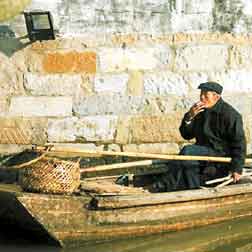
Among the well-preserved ancient towns and cities across China, Xitang is not nearly as well known as Pingyao in Shanxi Province, Lijiang in Yunnan Province or the Ancient Town of Zhouzhuang located in Jiangsu Province.
Even the locals in the ancient town of Xitang are surprised by the sudden increasing number of tourists to their quiet home in recent years.
Located at the junction of Zhejiang Province, Jiangsu Province and Shanghai Municipality, Xitang is a small town with densely distributed rivers and lakes.
Xitang is a typical ancient water-town of south China. The town is home to traditional architecture as well as legends and folklore.
As early as the Spring and Autumn and Warring States Periods (770-221BC), Xitang was a place of strategic importance on the boundary between the Wu and Yue states, and was thus known as the Bottom of Wu and the Corner of Yue. During the Yuan Dynasty (1271-1368), Xitang developed into a prosperous town, and during the Ming and Qing dynasties (1368-1911), it was known as an important town for commerce and handicrafts in south China.
Now, many well-preserved architectural styles constructed in the Ming and Qing dynasties can be seen in the town's many remaining buildings.
Unlike the crowds of tourists in Zhouzhuang, Xitang has a very quiet and natural environment, and has thus far avoided the droves of visitors.
Nine rivers cross the town and divide it into eight sections. A bird's-eye view of the town would show you many residents standing along the rivers, water flowing beneath the bridges, a thin silk-like mist hovering over the town, and tiled houses reflected inversely in the water.
A breezy day in April is the perfect time to visit the ancient town.
Bridges, lanes, and covered corridors are among the most impressing venues for visitors.
There are 104 bridges of varied structure, all from the Ming and Qing dynasties. Throughout the town are 122 lanes of varying width and length.
The lanes are paved with stones, polished by the feet of pedestrians and hundreds of years of weathering.
Covered walkways line the rivers.
Local residents have invented their own style of covered corridors as shelter from the rain due to the especially rainy weather in the area. Each family puts a ceiling over the stone road in front of their own house, and the ceilings connect with one another to form corridors, the longest being 1,300 meters. The walkway is like the corridor tourists can find in the Summer Palace, albeit a bit less extravagant.
Along one side of the riverside corridors, benches provide a resting place for pedestrians. It is rarely seen in other places, but it reflects the ancient and strong local custom of typical riverside villages along the lower reaches of the Yangtze.
The oldest quarter of the town, with many houses built in the Ming and Qing dynasties, is currently applying to be listed among the UNESCO World Heritage Sites together with three other South China waterside towns, including Zhouzhuang, Tongli and Wuzhen.
There are many suggested travel routes offered by local guides in Xitang. But any trip to the town is not complicated thanks to its small size. Usually one or two days are enough to visit Xitang.
You'd better stay at least one night to view the special night scenery where red lanterns brighten the rivers and town.
To get to Xitang from Beijing, going by train is relatively cheap and convenient as there are 10 different routes running between Beijing and Shanghai every day. Most of these routes leave Beijing in the evening (after 7 PM) and arrive in Shanghai the next morning. It takes about 12 hours and costs about 300 yuan (US$36) for a sleeping berth. A trip to Shanghai by air will save more time but often comes at a higher price. According to local media, some airlines offer good discounts that passenger can buy a one-way ticket for 240 yuan (US$29) in the off-peak season. Usually a 40 percent discount is offered by any airline if you purchase your ticket before May 1.
In Shanghai, you can take a train or bus to Jiashan. It takes 1.5 hours and costs 20 yuan (US$2.50) for the 90-kilometre trip.
In Jiashan, there is a bus leaving every five minutes for Xitang, a distance of about 10 kilometers. Bus tickets cost 3.5 yuan (US 42 cents).
Accommodation: Hotels in Xitang are cheap. The Xitang Hotel offers the best service. Usually a room with two beds costs 100 yuan (US$12.50) for one night and 120 yuan (US$14) for a room with three beds.
Photography enthusiasts are advised to stay in the Yue Jiao Ren Jia hotel. The top of the building is the best angel to get a full view of Xitang.
Qian Tang Ren Jia is a good restaurant with cheap and delicate dishes.
Varied snacks, including Xitang glutinous rice dumplings, meat steamed with rice flour and lotus leaves, Jiashan wine, Red-June River crabs and Eight-Immortal cakes are all available here.
(Beijing Weekend March 18, 2005)
|

